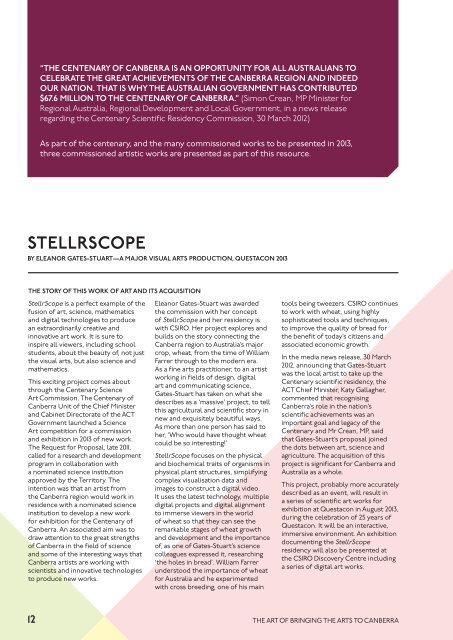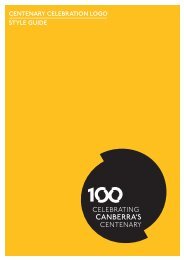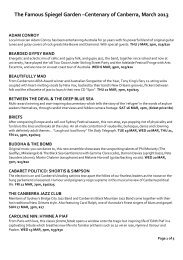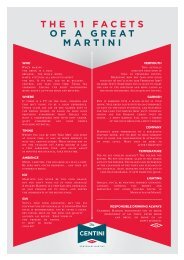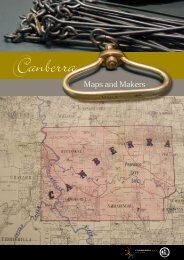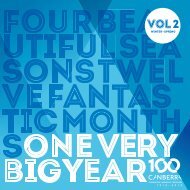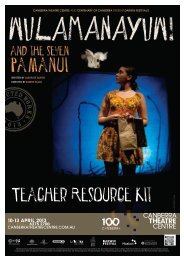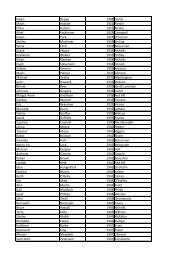THE ART - Canberra 100
THE ART - Canberra 100
THE ART - Canberra 100
You also want an ePaper? Increase the reach of your titles
YUMPU automatically turns print PDFs into web optimized ePapers that Google loves.
“<strong>THE</strong> CENTENARY OF CANBERRA IS AN OPPORTUNITY FOR ALL AUSTRALIANS TO<br />
CELEBRATE <strong>THE</strong> GREAT ACHIEVEMENTS OF <strong>THE</strong> CANBERRA REGION AND INDEED<br />
OUR NATION. THAT IS WHY <strong>THE</strong> AUSTRALIAN GOVERNMENT HAS CONTRIBUTED<br />
$67.6 MILLION TO <strong>THE</strong> CENTENARY OF CANBERRA.” (Simon Crean, MP Minister for<br />
Regional Australia, Regional Development and Local Government, in a news release<br />
regarding the Centenary Scientific Residency Commission, 30 March 2012)<br />
As part of the centenary, and the many commissioned works to be presented in 2013,<br />
three commissioned artistic works are presented as part of this resource.<br />
STELLRSCOPE<br />
BY ELEANOR GATES-STU<strong>ART</strong>—A MAJOR VISUAL <strong>ART</strong>S PRODUCTION, QUESTACON 2013<br />
<strong>THE</strong> STORY OF THIS WORK OF <strong>ART</strong> AND ITS ACQUISITION<br />
StellrScope is a perfect example of the<br />
fusion of art, science, mathematics<br />
and digital technologies to produce<br />
an extraordinarily creative and<br />
innovative art work. It is sure to<br />
inspire all viewers, including school<br />
students, about the beauty of, not just<br />
the visual arts, but also science and<br />
mathematics.<br />
This exciting project comes about<br />
through the Centenary Science<br />
Art Commission. The Centenary of<br />
<strong>Canberra</strong> Unit of the Chief Minister<br />
and Cabinet Directorate of the ACT<br />
Government launched a Science<br />
Art competition for a commission<br />
and exhibition in 2013 of new work.<br />
The Request for Proposal, late 2011,<br />
called for a research and development<br />
program in collaboration with<br />
a nominated science institution<br />
approved by the Territory. The<br />
intention was that an artist from<br />
the <strong>Canberra</strong> region would work in<br />
residence with a nominated science<br />
institution to develop a new work<br />
for exhibition for the Centenary of<br />
<strong>Canberra</strong>. An associated aim was to<br />
draw attention to the great strengths<br />
of <strong>Canberra</strong> in the field of science<br />
and some of the interesting ways that<br />
<strong>Canberra</strong> artists are working with<br />
scientists and innovative technologies<br />
to produce new works.<br />
Eleanor Gates-Stuart was awarded<br />
the commission with her concept<br />
of StellrScope and her residency is<br />
with CSIRO. Her project explores and<br />
builds on the story connecting the<br />
<strong>Canberra</strong> region to Australia’s major<br />
crop, wheat, from the time of William<br />
Farrer through to the modern era.<br />
As a fine arts practitioner, to an artist<br />
working in fields of design, digital<br />
art and communicating science,<br />
Gates-Stuart has taken on what she<br />
describes as a ‘massive’ project, to tell<br />
this agricultural and scientific story in<br />
new and exquisitely beautiful ways.<br />
As more than one person has said to<br />
her, ‘Who would have thought wheat<br />
could be so interesting!’<br />
StellrScope focuses on the physical<br />
and biochemical traits of organisms in<br />
physical plant structures, simplifying<br />
complex visualisation data and<br />
images to construct a digital video.<br />
It uses the latest technology, multiple<br />
digital projects and digital alignment<br />
to immerse viewers in the world<br />
of wheat so that they can see the<br />
remarkable stages of wheat growth<br />
and development and the importance<br />
of, as one of Gates-Stuart’s science<br />
colleagues expressed it, researching<br />
‘the holes in bread’. William Farrer<br />
understood the importance of wheat<br />
for Australia and he experimented<br />
with cross breeding, one of his main<br />
tools being tweezers. CSIRO continues<br />
to work with wheat, using highly<br />
sophisticated tools and techniques,<br />
to improve the quality of bread for<br />
the benefit of today’s citizens and<br />
associated economic growth.<br />
In the media news release, 30 March<br />
2012, announcing that Gates-Stuart<br />
was the local artist to take up the<br />
Centenary scientific residency, the<br />
ACT Chief Minister, Katy Gallagher,<br />
commented that recognising<br />
<strong>Canberra</strong>’s role in the nation’s<br />
scientific achievements was an<br />
important goal and legacy of the<br />
Centenary and Mr Crean, MP, said<br />
that Gates-Stuart’s proposal joined<br />
the dots between art, science and<br />
agriculture. The acquisition of this<br />
project is significant for <strong>Canberra</strong> and<br />
Australia as a whole.<br />
This project, probably more accurately<br />
described as an event, will result in<br />
a series of scientific art works for<br />
exhibition at Questacon in August 2013,<br />
during the celebration of 25 years of<br />
Questacon. It will be an interactive,<br />
immersive environment. An exhibition<br />
documenting the StellrScope<br />
residency will also be presented at<br />
the CSIRO Discovery Centre including<br />
a series of digital art works.<br />
12 <strong>THE</strong> <strong>ART</strong> OF BRINGING <strong>THE</strong> <strong>ART</strong>S TO CANBERRA


